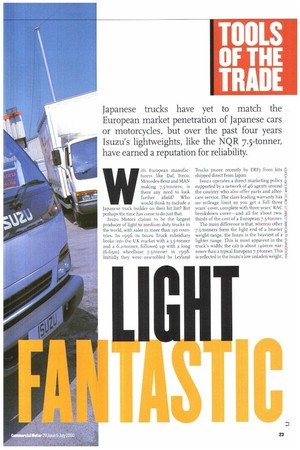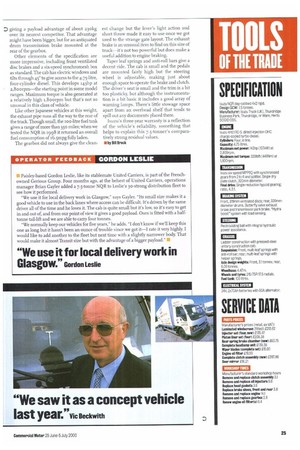Japanese trucks have yet to match the European market penetration
Page 25

Page 27

If you've noticed an error in this article please click here to report it so we can fix it.
of Japanese cars or motorcycles, but over the past four years Isuzu's lightweights, like the NQR 7.5-tonner, have earned a reputation for reliability.
ith European manufacturers like Daf, Iveco, Mercedes-Benz and MAN making 7.5-tonners, is there any need to look further afield? Who would think to include a Japanese truck builder on their hit list? But perhaps the time has come to do just that.
Isuzu Motors claims to be the largest producer of light to medium duty trucks in the world, with sales in more than 13o countries. In 1996 its Isuzu Truck subsidiary broke into the UK market with a 3.5-tonner and a 6.2.-tonner, followed up with a long (6.65m) wheelbase 7.5-tormer in 1998. Initially they were assembled by Leyland
Trucks (more recently by ERF) from kits T.1 shipped direct from Japan.
Isuzu operates a direct marketing policy supported by a network of 46 agents around the country who also offer parts and after,2 care service. The class-leading warranty has no mileage limit so you get a full three „F2 years' cover, complete with three years' RAC If breakdown cover—and all for about twothirds of the cost of a European 7.5-tormer. 8 The main difference is that, whereas other 7.5-tonners form the light end of a heavier ccI weight range, the Isuzu is the heaviest of a lighter range. This is most apparent in the truck's width: the cab is about 140mm narrower than a typical European 7.5-tonner. This Fg is reflected in the I suzu' s low unladen weight, E D giving a payload advantage of about 230kg over its nearest competitor. That advantage might have been bigger, but for an antiquated drum transmission brake mounted at the rear of the gearbox.
Other elements of the specification are more impressive, including front ventilated disc brakes and a six-speed synchromesh box as standard. The cab has electric windows and tilts through 45° to give access to the 4.75-litre, four-cylinder diesel. This develops 143hp at 2,800rpm—the starting point in some model ranges. Maximum torque is also generated at a relatively high 1,800rpm but that's not so unusual in this class of vehicle.
Like other Japanese vehicles at this weight, the exhaust pipe runs all the way to the rear of the truck. Though small, the Too-litre fuel tank gives a range of more than 350 miles; when we tested the NQR in 1998 it returned an overall fuel consumption of 16.5mpg fully laden.
The gearbox did not always give the clean
est change but the lever's light action and short throw made it easy to use once we got used to the strange gate layout. The exhaust brake is an unusual item to find on this size of truck—it's not too powerful but does make a useful addition to engine braking.
Taper leaf springs and anti-roll bars give a decent ride. The cab is small and the pedals are mounted fairly high but the steering wheel is adjustable, making just about enough space to operate the brake and clutch. The driver's seat is small and the trim is a bit too plasticky, but although the instrumentation is a bit 'basic it includes a good array of warning lamps. There's little stowage space apart from an overhead shelf that tends to spill out any documents placed there.
Isuzu's three-year warranty is a reflection of the vehicle's reliability, something that helps to explain this 7.5-tonner's comparatively strong residual values.
Eby Bill Brock












































































































